by Tom Frenaye, K1KI – frenaye@pcnet.com
Writeup | New England Scores | Scores from Outside New England | Breakdowns of Top Stations | Soapbox Comments
Introduction
It was good to see all of the activity during the first running of the New England QSO Party – we hope everyone enjoyed it! We had some last minute worries about getting all 67 counties on the air but that vanished by the end of the contest. We received 260 logs, split evenly between New England and non-New England stations.
Just about every weekend seems to be busy with contests, some small and some very large. The first weekend of May has been the traditional date for the Connecticut and Massachusetts QSO Parties, which have now been folded into the NEQP. Other events the same weekend included the ARI (Italian) DX Contest, the County Hunters CW Contest and the Indiana QSO Party. It seemed like they all were successful and in some cases activity may have been boosted by having multiple events at the same time.
Special thanks to the various software writers for adding the NEQP to their products – that really helped us to boost activity and to get logs into an electronic format for easier handling. Most of them even produced Cabrillo formatted output, though there were some rough edges.
One problem everyone faced was county names that were the same or very similar in multiple states. The county abbreviation list(s) helped out but some software had to use 3-letter abbreviations, and some used 5-letter abbreviations. There was some confusion over Bristol County in MA and RI, Essex County MA and VT, Franklin County in MA ME and VT, Hampden and Hampshire Counties in MA, Middlesex County CT and MA, Washington County in ME RI and VT, and Windham County CT and VT (plus Windsor County VT). You did need a scorecard to track them!
Special thanks to the clubs and individuals who sponsored plaques and other awards for this year’s event!
Hope you enjoy the contest summary – and please take the time to comment on the rules questions we have for the 2003 event – we have to finalize them by the end of December.
Propagation
When we selected the dates for the New England QSO Party one if the considerations was whether or not to move it earlier in the year so that 10 meters might have better propagation. By late May the sun is too far north and those good openings across the US and into Europe in high sunspot years are usually not possible. The other choices for weekends earlier in the year all had serious conflicts with other events.
Ten meters was no different than expected this year. From New England the most consistent, but weak, signals were from Florida, though late in the afternoon some found good openings to the west coast. Even so, activity was not high.
As expected, twenty meters was the workhorse band with most stations generating their biggest QSO totals there. A look through the logs from New England stations show 1567 different stations worked (those showing up in at least two logs) on 20 meters. Forty meters was the second most used band. The table below shows some additional information.
| 80m | 40m | 20m | 15m | 10m | |
| QSOs made by W1s | 952 | 7272 | 9866 | 4474 | 2087 |
| Different stations worked | 186 | 802 | 1567 | 823 | 514 |
There were no big solar flares to black things out but the WWV K-index did edge up almost to the disturbed level for much of the contest. When the index gets to K=4 propagation can be discouraging. When the K-index is 0 or 1 conditions are usually very good. It was at K=3 much of the time, just enough to make things seem just “OK” but conditions were not excellent.
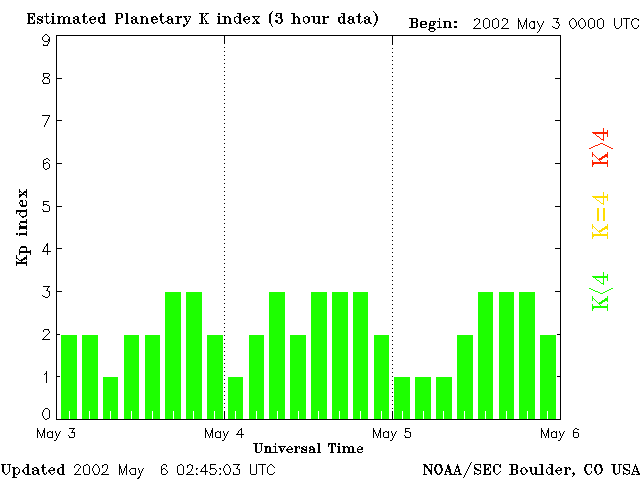
All in all, conditions were “good enough” to make QSOs possible for the entire contest period from New England, and for those within 2000 miles it appears that there was always at least one band open to New England. Those out 2500 miles or more probably found a few hours where it was not possible to find any W1 stations to work.
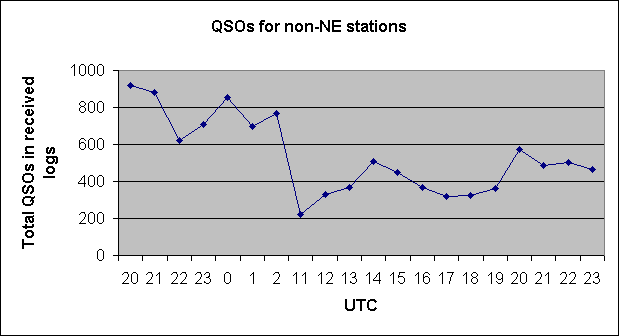
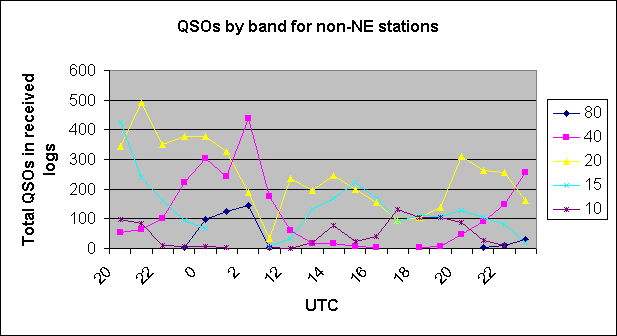
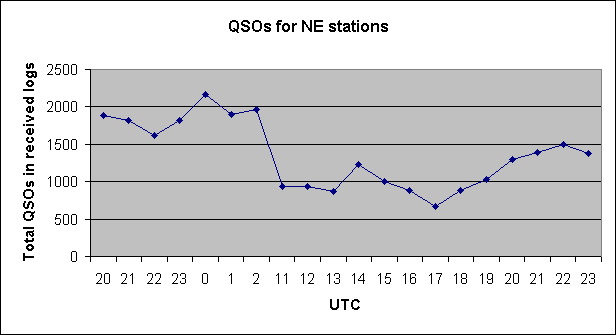
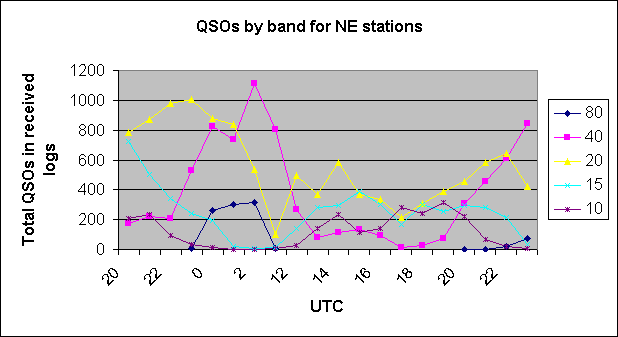
Mobiles and Portables
State QSO parties are more successful when there are lots of stations on, and especially when it is possible to work most or all counties during the contest period. The most successful state QSO parties ever were probably the Texas DX Society’s “Armadillo Run” efforts from the mid-1980s where there were dozens of mobiles and all 5th call area counties were on the air. In recent years, the Florida Contest Group’s Florida QSO Party has grown to be very successful because of the big effort to field mobiles – and some made around 2000 QSOs while mobile this year! Of course, the California QSO Party almost always has all counties available as well.
In this year’s NEQP, we received logs from 10 mobiles in New England, and eight outside of New England. Those outside of New England (KJ9C/m, VE2EM/W8/m, W3DYA/m and W9MSE/m (in five states!) were also participating in the County Hunters CW contest, and some of those in New England were doing it as well.
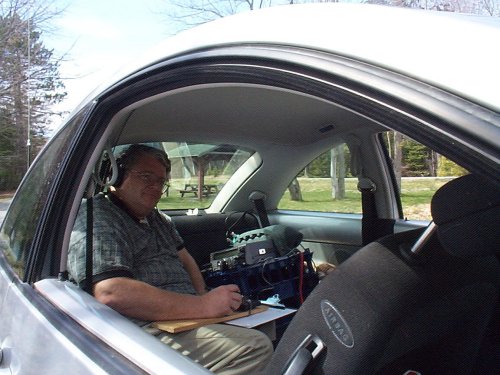
New England mobiles sending in logs were K1DG/m, K1EP/m, K1KI/m, K2HVN/m, K4MUT/m, KD1XH/m, N1KAT/m, N1RL/m, N1SR/m(+AA1TE), W1NY/m(KK1W+WB1Z), and W3SM/m. The N1SR/m team sped through 24 counties, while K1KI/m and K4MUT/m crossed into 16 and 15 counties. Mobiles insured that some of the rarest counties, mostly in northern New England, were active. AA1TE noted that the Boston Globe recently published an article that describes much of the trip that he and N1SR/m made: http://travel.boston.com/places/newengland/stories/100602_nh_connecticut_river.html
Portable operation by K1JB(3 counties), K2LE, K2KQ, NB1B, W1ACT, W1RH and W1UF also boosted the number of counties on the air during the contest. K1JB(+K1MV) flew between counties in a small plane and set up portable stations at the airports!
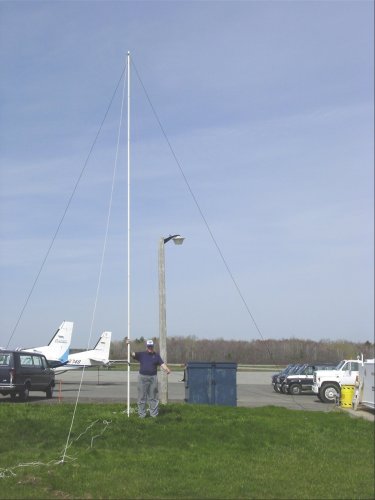
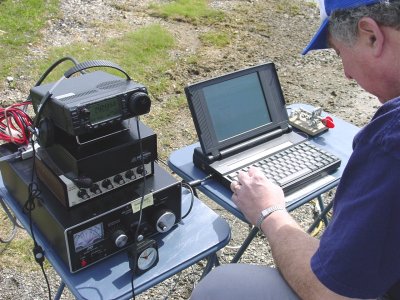
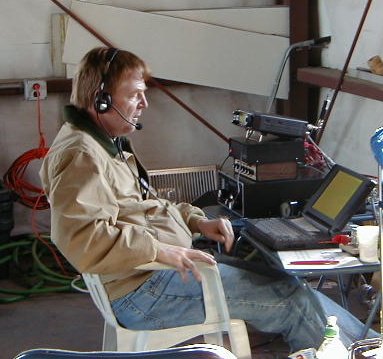
Please join us in 2003 to make sure there is lots of mobile/portable activity.
USA/VE/DX results
Check here for detailed results –> Score detail
One thing about single or multi-state QSO parties is that you generally do not have to turn your antennas during the contest, the geographic area is fairly limited. In New England the states are fairly small and the population is concentrated in the southern end. Of course that makes counties in the northern part of New England hard to find on the air. There are close to 550 miles separating the southwest corner of New England (just up the road from NYC) to the northern top of Maine where speaking French and watching auroras are commonplace!
Once you have your 20-15-10m antennas turned in the right direction (if directional and if they do turn…), the variables you have to worry about in order to score well are finding the right combination of band and mode to maximize the number of QSOs and multipliers. That takes some knowledge of propagation to pick the right band, or station flexibility to rapidly move between bands. If you have a loud enough signal as a result of antennas, propagation or your output power you may be able to work a good percentage of New England stations by calling CQ. Just answering CQs may not bring you a top QSO total – many stations prefer to answer CQs, or just don’t have a big enough signal to make CQing profitable.
The three biggest scores from outside of New England were fairly similar, though from different parts of the country. The W6YX crew at the Stanford ARC edged out a team led by KA6BIM for multi-operator honors. Dave/K6LL took up the challenge from his QTH in Yuma AZ in the single operator high power category, and Paul/N4PN joined the fray as a single operator low power entrant from Georgia.
From the West coast, W6YX and K6LL started on 10m SSB and moved back and forth to 15m during the first hour. The W6YX team had 38 QSOs and K6LL had 33 after the first hour, though K6LL had 6 more CW contacts and an edge in QSO points of 41 to 40. From Georgia, N4PN concentrated on 20m with one QSO on 15m for 21 in the first hour. The next three hours saw N4PN grabbing 89 more QSOs, with K6LL finding 93 and W6YX 60 – mostly on 20 and 15m though N4PN slipped down to 40m during the 23z hour. The three hours after 00Z (mostly after dark) were mostly on 20 and 40m, though W6YX found some success on 15m and N4PN on 80m. At the end of the evening N4PN had 167 QSOs, K6LL had 177 and W6YX had 184 in the log – with K6LL having the edge as a result of more CW QSOs.
On Sunday, all three started after 1130z (still quite early for those on the West coast). K6LL waited until about 14z to get started so the other two had a head start. From the East coast N4PN stayed on 20m and found 66 QSOs. It was tougher out West but W6YX dug out 43 QSOs starting on 40, then moving to 20 and 15. The rest of the contest saw each of them moving back and forth between CW and SSB, and 15 and 10m from the West coast, and mostly 20m from Georgia. QSO rates were fairly slow – about 40 an hour at most, dropping to 15 by the end of the contest. The key was to keep going, call some CQs, change bands, ask people to move to a new band or mode, etc. In the end both W6YX and N4PN had operated just under 18 of the 20 hours of the contest period. K6LL put in about 13.5 hours. The final totals show 384 QSOs and 31,062 points at the W6YX multi-op, 419 QSOs and 34,839 points at the K6LL single operator high power station, and the big score came from N4PN with 433 QSOs and 39,262 points. Each had about 1/3 of their QSOs on CW, with N4PN having the most with 35%.
As for multipliers, if you made 100 QSOs you probably came close to working 40 New England counties, and at 200 QSOs you might have reached 50 or so. The last 10-15 were fairly difficult, though they were all on the air. N4PN worked very hard and found all 67 – with the last one being with W1RH/P in Suffolk County (Boston city) MA. Other notable totals were the W6YX, KA6BIM and N0HF multi-ops with 62, 62 and 60, K6LL with 63, and N4BP with 60.
There were just a few QRP entries from outside of New England, and Jim/NA3V in Pennsylvania took the QRP title with 123 QSOs and 7,486 points. While PA is close to New England, that works fine on the low bands but on 20-15-10m he was too close in and had a tough time! Several mobile stations sent in entries, with VE2EM/W8/m in Michigan reaching the top with his 68 CW QSOs and 5,032 points.
The single operator low power category was by far the most popular with more than 75% of the out-of-New England entries. W8MJ turned in an excellent second place finish in that category with 344 QSOs and 29,854 points. He was also able to turn up QSOs with 59 of the 67 NE counties.
From the overseas end, Gedas/LY3BA edged out Clive/GM3POI for the DX title. Their single operator high power entries were significantly above the field of competition. LY3BA split his time almost evenly between CW and SSB, mostly on 20m for 231 QSOs and 60 (!) counties for 21,000 points, while GM3POI operated all CW for 179 QSOs, 47 multipliers and 16,826 points, even making a good number of. QSOs on 80m. It looks like total operating time made the difference between first and second place. The single operator low power and QRP category leaders were both from Poland, with Jan/SP2FWC edging out LA8OM for the LP win, and Gary/SP5AKG winning the QRP title.
About 40% of the entries were single mode – 35 were CW only and 23 were SSB only. Those with the biggest scores found that a combination of both modes really helped to boost the final totals. Some additional detail on top stations can be found here –> Band/mode breakdowns for top stations
A number of those participating had some special connections to New England, having once lived in the northeast. The crew at the N0HF multi-op mostly (all?) once lived in New England, for example. Please “phone home” again next year!
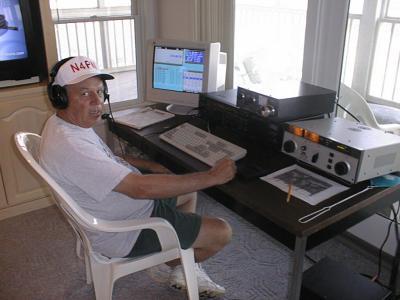
Two years before the NEQP, Paul/N4PN was an operator at W1AW/4 during the 2000 IARU HF Championship. During the 2002 NEQP Paul managed to snag a QSO with all 67 New England counties! Way to go, Paul!.
New England Results
Check here for detailed results –> Score detail
The beginning of the contest saw the multi-op group at K1TTT settle in on 21.380 SSB as their starting point, while Dennis/NB1B decided that 21.040 CW was the right spot, and Martin/AA1ON’s choice was 10m SSB. All got off to a good start with K1TTT logging 78 QSOs, AA1ON finding 77 QSOs (including a move to 15m CW, then SSB to grab 59 of them), and NB1B putting 83 in his log (66 on CW). The next three hours saw NB1B staying mostly on 20m and racking up hours of 82-121-112, AA1ON with 70-119-86 and K1TTT with 78-67-69. By the end of the evening (0300z), AA1ON had the QSO lead after spending some very productive time on 20m SSB on 40m CW while K1TTT and NB1B couldn’t quite keep pace. The night ended with AA1ON at 649 QSOs, NB1B at 593 and K1TTT at 574 QSOs. Since CW QSOs are worth 2 points, though, NB1B and K1TTT actually were ahead of AA1ON because they had about 140 more CW QSOs.
The next morning everyone liked 40m CW the best during the 11z hour, though SSB was also pressed into service. At 12z the action had moved to 20m, and during the 13z hour the bulk of the QSOs were on 15m. NB1B kept hammering away on CW while, AA1ON and K1TTT tended to favor the better rates on SSB. Rates tended to be in the 40-50 per hour range, though K1TTT found 94 in the 14z hour on 20m SSB. Each tried some 10m SSB activity during the afternoon with modest success by as the afternoon proceeded, they could see that 10m wasn’t going to bust wide open – except to the West coast. Most stations were switching back and forth between 20 and 15m, CW and SSB. The last two hours were spent on 40 and 20m, except that NB1B found 80m to be good in that last hour. K1TTT made the most of the final few hours by concentrating on CW QSOs.
The bottom line was that NB1B earned the single operator high power victory with 1232 QSOs (48% CW, 52% SSB), and AA1ON came in second with 1295 QSOs (28% CW, 72% SSB). The K1TTT multi-op team was the leader in their category with 1243 QSOs (43% CW, 57% SSB). Point totals were 140,140 for NB1B, 137,368 for K1TTT, and 126,084 for AA1ON. Trying to maximize the scores is an interesting process when rates are generally higher on SSB, but points per QSO are higher for CW. Multiplier totals for each of the three stations was almost identical, with NB1B and K1TTT finding 77 and AA1ON very close behind with 76.
Low power leader (72,352 points) Joe/NY1S found that CW was the most productive for him – and he made 481 of his 583 QSOs on CW (82%) and finished with a comfortable margin over KS1J’s 466 QSO tally. New England QRP stations also favored CW, with Tom/AA1CA putting all of his 267 QSOs (28,302 points) in the log on CW. Mobile activity also tended to favor CW operation.
In order to do well, most New England participants found they had to spend some time on each mode, though 17 operated on CW only and 49 just made SSB QSOs. Some additional detail on top stations can be found here –> Band/mode breakdowns for top stations
About half of the New England stations submitted scores for a club, with the YCCC getting the largest share of the points. Quite a number of other clubs also had logs submitted on their behalf – we’d like to see the number increase next year. While some of the top scorers were experienced contesters, many were not. Quite a number had never operated in a QSO party before, though might have had some experience at Field Day. We hope you’ll all be back!
Who are the “Multiplier Kings”?
Who worked all of the counties in each New England state?
All sixty-seven New England counties were on the air during the 2002 New England QSO Party. Only one station managed to work them all. There were eighteen stations who worked all Connecticut counties, and fifteen who worked them all in Rhode Island. Working all Massachusetts counties was surprisingly hard and, as might be expected, Vermont and Maine were very tough.
N4PN‘s single operator low power effort of working all counties in each state (67) is worthy of special note (and a special award). A couple of DX stations did well also, with GM3POI snagging all counties in New Hampshire and LY3BA making QSOs with all of them in Connecticut and Rhode Island. Five California stations worked all counties in Connecticut and seven worked all of them in Rhode Island. NA3V even managed to work all counties in Connecticut using his QRP station in Pennsylvania.
| Worked all Connecticut counties (8) | ||
| Call | QTH | Category |
| W6YX | California | MS |
| KA6BIM | California | MS |
| N0HF | Colorado | MS |
| K6LL | Arizona | SOHP |
| LY3BA | Lithuania | SOHP |
| K6RB | California | SOHP |
| UA4LCH | European Russia | SOHP |
| N4PN | Georgia | SOLP |
| W8MJ | Michigan | SOLP |
| N4BP | Florida | SOLP |
| N6ZFO | California | SOLP |
| K5DB | Arkansas | SOLP |
| WN6K | California | SOLP |
| WA4VEK | Alabama | SOLP |
| KE5OG | Texas | SOLP |
| N5FPW | North Carolina | SOLP |
| N0YYO | Kansas | SOLP |
| NA3V | Pennsylvania | SOQRP |
| Worked all Massachusetts counties (14) | ||
| Call | QTH | Category |
| N0HF | Colorado | MS |
| K6LL | Arizona | SOHP |
| N4PN | Georgia | SOLP |
| VE2AWR | Quebec | SOLP |
| Worked all Maine counties (16) | ||
| Call | QTH | Category |
| N4PN | Georgia | SOLP |
| Worked all New Hampshire counties (10) | ||
| Call | QTH | Category |
| GM3POI | Scotland | SOHP |
| N4PN | Georgia | SOLP |
| Worked all Rhode Island counties (5) | ||
| Call | QTH | Category |
| W6YX | California | MS |
| KA6BIM | California | MS |
| N0HF | Colorado | MS |
| K6LL | Arizona | SOHP |
| LY3BA | Lithuania | SOHP |
| K6RB | California | SOHP |
| N4PN | Georgia | SOLP |
| W8MJ | Michigan | SOLP |
| N4BP | Florida | SOLP |
| N6ZFO | California | SOLP |
| WN6K | California | SOLP |
| WA4VEK | Alabama | SOLP |
| AE6Y | California | SOLP |
| KE5OG | Texas | SOLP |
| W1PR/6 | California | SOLP |
| N5YE | Louisiana | SOLP |
| Worked all Vermont counties (14) | ||
| Call | QTH | Category |
| N4PN | Georgia | SOLP |
What about the New England stations?
Both NB1B and K1TTT managed to work all 50 states, while AA1ON, W1YK and N1SV came up one short. No one worked all of the Canadian multipliers – NB1B, K1TTT and AA1ON each found seven of them.; Only one station worked a VE8, and no one reported working VY1, VY2 or VY0. Sixteen stations worked 20 or more DX countries – the maximum permitted under the rules.
| Worked all US States (50) | ||
| Call | QTH | Category |
| K1TTT | BER MA | MS |
| NB1B | BRI MA | SOHP |
| Worked at least 20 DX countries | ||
| Call | QTH | Category |
| K1TTT | BER MA | MS |
| W1OP | PRO RI | MS |
| AG1C | MID MA | MS |
| NB1B | BRI MA | SOHP |
| AA1ON | MID MA | SOHP |
| K1ZZ | TOL CT | SOHP |
| K5ZD | WOR MA | SOHP |
| K1GU | MID MA | SOHP |
| K1PQS | PEN ME | SOHP |
| W1UK | TOL CT | SOHP |
| K1RX | ROC NH | SOHP |
| K2LE/1 | BEN VT | SOHP |
| KS1J | BRI RI | SOLP |
| K2KQ/1 | DUK MA | SOLP |
| K1XM | MID MA | SOLP |
| K1KI/m | 16 counties | SOLP-m |
Club Competition
Looks like the Yankee Clipper Contest Club ran away with the club competition this time! Since they are sponsoring the plaque for the top club competition score this year, the plaque will go to the CT-RI Contest Group. Special mention should be made of the Framingham ARA, Candlewood ARA, Hampden County RA and Meriden ARC, who all generated at least four entries. About half of the New England entrants did not indicate a club name, though it is obvious that many belonged to one of the clubs listed below. Make sure to add your club name to your entry next time.
| Club | Points | Entries |
| Yankee Clipper Contest Club | 1,055,076 | 35 |
| CT-RI Contest Group | 70,018 | 4 |
| WPI Wireless Assn | 57,553 | 1 |
| Framingham ARA | 56,552 | 5 |
| Providence RA | 45,290 | 1 |
| Candlewood ARA | 41,094 | 4 |
| Contoocook Valley RC | 22,638 | 2 |
| Lincoln County ARC | 21,448 | 1 |
| New England QRP Club | 19,178 | 1 |
| Hampden County RA | 19,076 | 4 |
| Eastern CT ARA | 17,690 | 1 |
| Green Mountain Wireless | 11,388 | 1 |
| ECARA | 11,020 | 1 |
| Blackstone Valley ARC | 8,800 | 1 |
| Southern VT ARC | 7,525 | 1 |
| Falmouth ARA | 6,324 | 1 |
| CT Amateur Radio League of Youth | 4,625 | 1 |
| Meriden ARC | 4,588 | 5 |
| Piscataquis ARC | 4,059 | 1 |
| Fall River ARC | 3,570 | 1 |
| Twin State RC | 3,285 | 2 |
| Sturdy Memorial Hospital ARC | 874 | 1 |
| Algonquin Amateur Radio Club | 364 | 1 |
Activity by County
We worked hard to make sure that all New England counties were active during the NEQP – there were actually at least two stations active in each county. It was still quite difficult to work them all. N4PN was the only station to put in the right combination of operating hours and time spent on both CW and SSB to work all 67 counties.
Here’s a summary of activity by county reported in non-New England logs – note that only two stations were active in Franklin, Piscataquis, Sagadahoc, and Somerset counties (ME), and in Strafford County (NH). Stations reported the least number of QSOs made with five other counties though – Franklin County (MA), Sullivan County (NH) and Lamoille, Grand Isle and Washington counties (VT). Middlesex County (MA) was by far the most often worked county! ;
| County | State | QSOs | Stations (in min 2 logs) |
| Middlesex | MA | 1322 | 36 |
| Hillsboro | NH | 629 | 25 |
| Rockingham | NH | 502 | 19 |
| Cheshire | NH | 492 | 9 |
| Windham | CT | 472 | 9 |
| Worcester | MA | 440 | 21 |
| Fairfield | CT | 427 | 18 |
| Berkshire | MA | 387 | 5 |
| Bristol | MA | 358 | 15 |
| Tolland | CT | 330 | 7 |
| Penobscot | ME | 295 | 12 |
| Essex | MA | 265 | 18 |
| Hancock | ME | 261 | 8 |
| New Haven | CT | 241 | 23 |
| Providence | RI | 232 | 12 |
| Dukes | MA | 188 | 3 |
| Bristol | RI | 183 | 6 |
| Washington | ME | 174 | 5 |
| Grafton | NH | 160 | 10 |
| Chittenden | VT | 157 | 7 |
| Bennington | VT | 154 | 7 |
| Hartford | CT | 154 | 16 |
| Knox | ME | 151 | 3 |
| Windsor | VT | 148 | 9 |
| New London | CT | 134 | 10 |
| York | ME | 133 | 5 |
| Plymouth | MA | 132 | 10 |
| Lincoln | ME | 131 | 3 |
| Norfolk | MA | 128 | 16 |
| Barnstable | MA | 120 | 8 |
| Coos | NH | 100 | 8 |
| Hampden | MA | 93 | 15 |
| Rutland | VT | 77 | 4 |
| Cumberland | ME | 72 | 8 |
| Kent | RI | 69 | 10 |
| Merrimac | NH | 65 | 10 |
| Addison | VT | 62 | 5 |
| Kenebec | ME | 60 | 6 |
| Piscataquis | ME | 57 | 2 |
| Strafford | NH | 56 | 2 |
| Litchfield | CT | 55 | 5 |
| Suffolk | MA | 54 | 3 |
| Newport | RI | 53 | 4 |
| Washington | RI | 53 | 7 |
| Essex | VT | 52 | 4 |
| Nantucket | MA | 51 | 3 |
| Caledonia | VT | 48 | 4 |
| Franklin | VT | 46 | 4 |
| Carroll | NH | 45 | 9 |
| Middlesex | CT | 44 | 6 |
| Sagadahoc | ME | 43 | 2 |
| Belknap | NH | 38 | 9 |
| Orange | VT | 38 | 6 |
| Oxford | ME | 38 | 5 |
| Hampshire | MA | 34 | 7 |
| Waldo | ME | 33 | 3 |
| Orleans | VT | 32 | 4 |
| Aroostook | ME | 30 | 3 |
| Franklin | ME | 28 | 2 |
| Somerset | ME | 27 | 2 |
| Androscoggin | ME | 26 | 3 |
| Windham | VT | 25 | 7 |
| Lamoille | VT | 24 | 3 |
| Sullivan | NH | 23 | 3 |
| Grand Isle | VT | 17 | 3 |
| Washington | VT | 15 | 3 |
| Franklin | MA | 13 | 5 |
Certificates!
Turns out about 85% of those sending in logs had more than 25 QSOs, so we’re sending out participation certificates to everyone, along with the results. Thanks to Scott/W1QHG for doing the certificate design work!

 | 2002 New England QSO Party Plaques and Special Awards |  |
Certificates will be awarded to all who entered in the first year of the New England QSO Party.
Special plaques have been awarded to these top scorers:
| Category | Donor | Winner |
| USA – single operator | Southborough Rod & Gun Club (W1SRG) | Paul Newberry, N4PN |
| USA – single operator low power | Laci Radnay, W1PL | Paul Newberry, N4PN |
| USA – single operator QRP | Joe Zdrojowy, NY1S | Jim Gooch, NA3V |
| USA – single opr(W5-W6-W7-W0) | Huckleberry Mountain Contest Club (W1SSB) | Dave Hachadorian, K6LL |
| USA – any category (California/Nevada) | Calif QSO Party – Northern California Contest Club | Stanford ARC – W6YX (W6LD N7MH K6ENT W7SW N6DE operators) |
| DX – single operator | Yankee Clipper Contest Club | Gedas Lucinskas, LY3BA |
| Clean Sweep – Not First, but Furthest | Dennis Egan, NB1B | Paul Newberry, N4PN |
| New England – single operator | Yankee Clipper Contest Club | Dennis Egan, NB1B |
| New England – single operator – low power | Algonquin Amateur Radio Club | Joe Zdrojowy, NY1S |
| New England – single operator – QRP | Blackstone Valley Amateur Radio Club | Tom Doubek, AA1CA |
| New England mobile – most counties activated | Tom Frenaye, K1KI | Steve Rodowicz, N1SR/m (+Dan Sullivan, AA1TE) |
| New England mobile – most QSOs | Boston Amateur Radio Club | Tom Frenaye, K1KI/m |
| New England – multi-single | Wellesley ARS | Dave Robbins, K1TTT (+Tom Homewood, W1TO, Brian Szewczyk, NJ1F) |
| Connecticut – single operator | Candlewood ARA | Dave Sumner, K1ZZ |
| Maine – single operator | Merrymeeting ARA, Androscoggin ARC, Yankee ARC, Portland Amateur Wireless Assn, Piscataquis ARC | Joe Zdrojowy, NY1S |
| Massachusetts – single operator | Framingham Amateur Radio Association | Dennis Egan, NB1B |
| New Hampshire – single operator | NH-ARRL | Rex Lint, K1HI |
| Rhode Island – single operator | CT/RI Contest Group | Jim Bowman, KS1J |
| Vermont – single operator | Jim Jarvis, N2EA | Mill Moore, K1IB |
| MA – Hampden County – single operator | Hampden County Radio Association | Dave Isham, KB1MU |
| New England Club | Yankee Clipper Contest Club | CT-RI Contest Group – WA1RR |
If you’d like to sponsor a plaque for 2003, please contact us at info@neqp.org
Special Awards
For the top USA (non-New England) single operator winner: The Framingham Amateur Radio Association has donated a Lobster dinner for two from Legal Seafood of Boston to the USA single op (non-New England) winner.
For 2002 the winner is Paul Newberry, N4PN!
For other top USA (non-New England) scorers:
- Ben & Jerry’s Ice Cream – 250+ QSOs
- W6YX KA6BIM N0HF K6LL W8MJ N4BP
- Maple Syrup – 150+ QSOs
- W4/G4BUE K6RB N4CW K1PT N6ZFO WJ9B K5DB WN6K WA1UJU K4BEV WA4VEK KE5OG
Certificates and plaques will be mailed out during the next couple of months – thanks for your patience!
Log checking
Thanks to everyone who sent in electronic logs, it made the log checking process go much easier. There were 260 logs overall, with 193 in electronic format (74%) and 67 on paper. We took the time to convert all of the paper logs to electronic format for log checking. Even though a large percentage of them came in electronic format, nearly all Cabrillo, almost all of them had some problems to resolve. The NEQP was a new addition to all logging programs and each one had some slight differences from the Cabrillo format. The most common user errors were not having your callsign and QTH set up properly in the contest setup screen, having your computer clock set to local (or some other) time, or not specifying your entry category. Thanks to those who responded to our e-mail questions on missing information.
This year we had the time and resources to do a complete cross checking of logs. With 130 logs from New England and 130 from outside New England we have a high percentage of logs from active participants.
For non-New England stations, cross checking was possible on 7,881 of the 11,198 QSOs reported (70.4%). Of the 452 QSOs not allowed (5.7%), the break down is as follows:
| QSOs | Reason not allowed |
|---|---|
| 139 | Callsign incorrect |
| 88 | QTH incorrect |
| 92 | Not in log |
| 85 | Duplicate |
| 34 | Time was outside of contest period |
| 13 | Non-NE station |
| 1 | Misc |
| 452 | Total of QSOs disallowed |
For New England stations, cross checking was possible on 12,005 of the 28,396 QSOs reported (42.3%). Of the 1121 QSOs not allowed (3.9%), the break down is as follows:
| QSOs | Reason not allowed |
|---|---|
| 342 | Callsign incorrect |
| 153 | QTH incorrect |
| 93 | Not in log |
| 513 | Duplicate |
| 20 | Time was outside of contest period |
| 1,121 | Total of QSOs disallowed |
Of course, people are encouraged to leave duplicates in the log and there is typically no penalty for duplicates. We consider contacts made outside of the contest period in the same category (some people used the same log for other contests that weekend). The errors that “count” are those where you got the callsign or QTH wrong, or where the QSO didn’t appear in the other station’s log. We didn’t assess any extra penalty for any of the callsign, QTH or not in log errors – but are considering it for the 2003 contest.
Most stations had remarkably low error rates, especially those with more experience who made more QSOs. The highest error rates (> 5%) were from stations outside of New England making less than 100 QSOs, or those inside New England making less than 200 QSOs. The top scoring stations from either group had error rates under 2%. A more detailed graph is available –> Error Summary
2003 NEQP Rules – Your input requested!
We had a lot of discussions while establishing the rules for the first NEQP and seem to have settled on a successful format. There are some areas where people have made suggestions, and where the results suggest some changes might be useful. We’d appreciate your input and suggestions on any of the NEQP rules – please send them send to info@neqp.org or P O Box 3005, Framingham MA 01705-3005
NE stations work NE counties?
The present rules do not give New England stations a multiplier for NE counties, just states. Several NE stations suggested we should add NE counties to the NE multiplier. That would change it from 84 (50 states, 14 Canadian provinces, max of 20 DX countries) to 145 (67 counties, 44 states, 14 provinces, 20 countries), and would alter the strategy used by NE stations. It would certainly generate more low band activity, even during the day. We didn’t choose to set up the rules for 2002 that way because we wanted NEQP activity to attract serious competitors from across the country(and elsewhere), not just the eastern USA. That appeared to be the best way to generate the most activity. Any really strong reasons to change?
Some NE stations logged the state-county for NE stations, some only logged the state. We credited the QSO either way this time. What should we do for 2003 – should we require NE stations to copy the state-county for other NE stations, even if they don’t get multiplier credit for the county?
Contest time period?
The time period for state QSO parties varies considerably. Some do it all in 10-12 hours, some go for a full 48 hours, with some off-times. We decided that a total of 20 hours was about right – it would allow for good coverage of the hours when most people are likely to want to be on the air. We also wanted to avoid a conflict with New England’s biggest flea market (Hosstraders) – which ends around 17z. Hosstraders turned out to be a good place for some mobiles to meet before the contest!
Comments received from the logs and otherwise suggest that it might be useful to consider some change in the hours. The 2002 contest ran from 20z Saturday until 03z Sunday, and from 11z-24z on Sunday. Activity was quite good in the 02-03z hour Saturday night local time, and an extra hour or two was suggested. Similarly, at 11z on Sunday morning the activity was fairly low – so perhaps delaying the start time on Sunday for an hour or two would also be useful – leaving the total contest time at 20 hours. How about 20z-05z and 13z-24z?
What bands?
Originally there was some hope that we could generate a fair amount of VHF activity – the previous individual state QSO parties in New England had suggested VHF frequencies so they had hoped for some as well. As it turned out, the was very little VHF activity. There was also almost no activity on 160m.
| Band | Different stations | Total QSOs | Notes |
| 160m | 2 | 3 | all within NE |
| 6m | 2 | 5 | all within NE |
| 2m | 17 | 26 | one non-NE station |
| 70cm | 1 | 1 | all within NE |
May is not a popular time for 160m activity, so should we include it? We’re most likely to drop the VHF bands for next year. More thinking about it suggests that perhaps some day a contest targeting just VHF bands and using NE counties as a multiplier for all stations might make for a lot of fun. If the NEQP “grows up” and continues to be successful maybe we can try organizing a VHF NEQP with separate rules.
DX multipliers
When we started defining the rules for the NEQP we resolved to make sure that the rules were fairly simple and could easily be implemented by those writing contest logging software. We managed to do pretty well at it – all of the popular programs now include the NEQP. One rules that “slipped” through was the one limiting NE stations to a maximum DX multiplier of 20. That one was added to try to keep the focus of the contest on working stations most likely to be sending in logs, not those workable in large numbers by pointing antennas to Europe. Sixteen of the 130 entries from New England worked 20 or more DX countries – with the highest something like 45 or 50 countries. Were we too conservative with that rule and eliminate it for next year, or did it have a useful result?
Multiple county operation
One of the things we didn’t anticipate in the rules was a New England station that operated from home and as a mobile as well, or from multiple portable locations. In the end we decided to score them the same way we score mobiles who go to different counties – the total score is the total number of QSO points times the number of multipliers worked overall, but we also report scores made in each county.
For non-New England stations, mobiles in different counties in the same state are scored as if they were home stations (a second QSO with W1ABC when mobile from a new county is counted as a duplicate). Someone who is mobile in a new state (like W9MSE/m was) can submit logs for each state and they are scored separately. Seem like a reasonable way to handle it?
Thanks in advance for your comments!
NEQP Discussion Mailing List
We established an e-mail reflector while we were organizing the NEQP, and it helped us to work out various issues and share ideas. It was a closed e-mail reflector used just by the organizers. Now that the NEQP is “off the ground” we’ve converted the mailing list so it can be used by everyone interested in the NEQP. You can use it to pass along comments, suggestions and ideas, to let us know about your plans for the next NEQP, or just to keep an ear on whatever activity there may be between now and then.
To join, go to this URL –> http://www.kkn.net/mailman/listinfo/neqp
Soapbox
What the heck is a soapbox? The Merriam-Webster dictionary (http://www.m-w.com/) says:
- an improvised platform used by a self-appointed, spontaneous, or informal orator;
- broadly : something that provides an outlet for delivering opinions
So, I guess you’ll find some spontaneous discussion and opinions from NEQP participants in the pages of soapbox comments –> soapbox
Thanks
A number of people helped out in lots of ways to make the 2002 NEQP successful. I especially want to thank Bob/W1RH for his work in pulling things together, talking to several groups about the contest and in finding plaque sponsors.